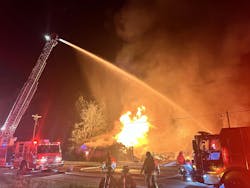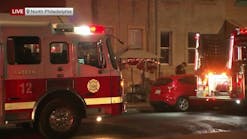Community Risk Reduction: Knowing History
For community risk reduction (CRR) to effect long-term change, tragic events must be perceived as a continuous threat to all, not simply random acts of misfortune that happen to others.
CRR in today’s fire service should encompass an all-hazards approach. Whether it be a fall and injury or an industrial incident or a natural disaster, if we respond to it and mitigate it, then we should be able to educate people on how to prevent it or to reduce its effects. However, at the end of the day—and where the rubber meets the road—our core service is fire protection, and in regard to that, fire departments are the only game in town.
Fire Prevention Week comprises seven days that are dedicated for the fire service to educate communities on the dangers of fire. Although fires and fire loss dropped dramatically since the declaration of the first Fire Prevention Day in 1920 (becoming a full week in 1922), and with an accelerated decline following the 1973 publishing of “America Burning,” arguably, fires and fire deaths today plateaued, with only slight fluctuations up and down.
According to the NFPA, in 1999, 3,570 people died in fire, and in the latest NFPA Fire Loss Report, in 2022, 3,790 people died in fire. That’s the wrong direction. In addition, according to the NFPA, although overall fires are down since the 1980s, the rate at which people die in them is increased today.
Why are we losing, or at best at a stalemate, in our war for fire prevention? Why is humankind’s oldest tool still one of the deadliest in United States? Why isn’t the public outraged enough about the needless loss of life that’s caused by fire that they start to demand better fire protection?
On Sept. 11, 2001, 2,977 people died during the terrorist attacks. Even though the attacks took place on the East Coast, every American felt the effect and fear of terrorism, to such a degree, in fact, that they were willing to accept travel inconveniences and compromises on personal freedoms.
In 2005, Hurricane Katrina claimed 1,392 lives, again affecting only a specific area of the country, but the ensuing public outrage caused major changes to the government’s response and funding for disasters.
During the War on Terror that followed 9/11, when the public learned that soldiers didn’t have the proper protection against improvised explosive devices (IEDs), there was such a public outcry that lawmakers raced to find funding, and when the loss of life in Iraq was perceived to be too high, public pressure played a role in bringing that war to a close.
What was it about these events that caused such an uproar from citizens who were completely removed and uninvolved in them that lawmakers took action to prevent or reduce further loss?
Sprinkler system apathy
Fire kills more Americans every year than terrorism and natural disasters combined. It disproportionately affects the most vulnerable in society—the very young and the elderly—where people should feel the most secure, in their home. Yet after a fire tragedy, any outrage or demand by citizens, if any at all, seems short-lived and unfocused. When such a tragedy occurs, as part of CRR, we must provide more than just a momentary lesson for that one specific event. We must fully educate the community not only on what occurred but what continues to occur as a result of society’s refusal to address a serious risk that causes such needless losses.
Sprinkler systems are to the fire service what a cure for cancer would be to the health profession. This effective weapon not only helps to prevent fire loss but also ensures that “everyone goes home.” Sprinkler systems would all but eradicate fire loss and death and save millions of lives and properties, yet there is no public outcry for their universal use. In fact, not only are lawmakers largely apathetic toward sprinkler systems, but elected officials also often openly oppose them without any fear of repercussions at the ballot box, because voters are largely uneducated about them and the dangers of fire.
The Station tragedy
Fire often is perceived as a random incident of misfortune that happens to someone else and that, although tragic, is largely unavoidable and simply a reality of life. That said, an event comes along now and again that grabs enough national attention to make the fire risk real and unacceptable and subsequently results in calls for immediate action from an outraged public.
In February 2003, 100 people died in an overcrowded West Warwick, RI, night club called The Station. The real-time video that was captured by a patron who was inside of the club showed the fire’s growth and ensuing panic, along with the dead and dying trapped at the main entrance. Much like images of the 9/11 attacks, Hurricane Katrina and the War on Terror, this live video footage brought the horrors of fire loss into homes across the nation, which made it real and unacceptable and resulted in demands for action. The fire brought about many recommendations and changes to standards and codes, but the most notable code change involved sprinkler systems. Previous to this fire, assembly occupancies that are used for food or drink consumption weren’t required to have a sprinkler system until the occupancy load of the building reached 300 people. According to the International Code Council (ICC), as a result of this fire, the occupancy load was reduced to 100 from 300 with very little debate or opposition.
In 2008, the requirement for sprinkler systems in residential occupancies was approved by the ICC for inclusion in the 2009 edition of the International Residential Code (IRC). It seemed that the 2003 fire at The Station might have been the catalyst to finally get the public outraged enough for permanent change to reduce, if not eliminate, the fire risk, or so it seemed. The National Association of Home Builders (NAHB) opposed this mandate and sought to have it appealed. Leading up to the vote for the code change, in 2006, the NAHB commissioned a public survey of 800 likely voters. According to the NAHB, when surveytakers were asked to choose a free option for a newly built home, two-thirds of those people chose an option other than a fire sprinkler system, with a finished basement being the top choice of those who completed the survey. Eighty-nine percent of those who were surveyed believed that they were safe enough in their home—where they are most at risk—with smoke alarms considered being adequate enough.
Although the sprinkler system mandate eventually was adopted in the IRC, once again, many lawmakers brazenly chose to eliminate or reduce that section in their code adoptions. It seems that the loss of life at The Station, which shocked a nation, wasn’t the tidal wave that was needed for permanent change and risk reduction. Instead, it was a simple wave that crashed ashore long enough to catch people’s attention but then receded quickly, and along with it, the demands and outrage.
A broader focus
Society once again slid apathetically into seeing The Station as an unavoidable, isolated incident that was tragic, rather than another needless loss of life because of society’s refusal to address the issue of fire loss. The public began to distance themselves from this risk, in part because the fire service’s focus was on just this single tragedy. The public didn’t know about the 1903 Iroquois Theater fire in Chicago, where a lack of sprinkler systems and issues with exits resulted in at least 600 fatalities. The public didn’t know about the 1942 Cocoanut Grove fire in Boston, where a lack of sprinkler systems and issues with exits resulted in 492 fatalities. Citizens didn’t know about the 1977 Beverly Hills Supper Club fire in Kentucky, where a lack of sprinkler systems and issues with exits resulted in 165 fatalities, nor the thousands of other fire fatalities before and after with the same recurring themes.
Had the fire service continually educated communities about these fires, demonstrating that The Station fire wasn’t an isolated incident but one more link in a long chain of fire losses that could have been prevented, the tragedy in West Warwick might have been the tidal wave that was needed to demand permanent change and risk reduction by a now fed up and outraged society that would demand it. We didn’t, so they didn’t, and this year, fire again will be a leading cause of death in the United States.

Daniel Byrne
DANIEL BYRNE is a community support officer for the Burton Fire District, Beaufort County, SC, and a retired assistant fire chief of training for the Georgia Air National Guard 165th Fire Department. A third-generation firefighter, he holds an associate degree and a bachelor’s degree in fire science as well as a master’s degree in public administration and disaster management. Byrne is an alumnus of the National Fire Academy. He received state and local awards for public relations and educational programs as well as community partnerships and served as a conference presenter and keynote speaker.






